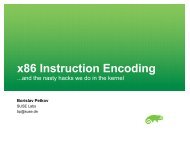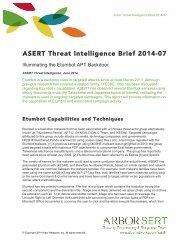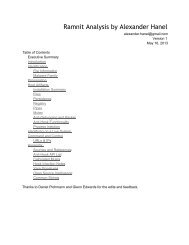Resources
1Va83Wx
1Va83Wx
- No tags were found...
You also want an ePaper? Increase the reach of your titles
YUMPU automatically turns print PDFs into web optimized ePapers that Google loves.
Page 6<br />
www.osr.com<br />
n case you've been busy worrying about writing code for existing projects and stuff, let me call your attention to some big<br />
I changes in the realm of driver signing that start with Windows 10.<br />
There's been an ongoing thread on NTDEV about this topic for more than a month now that has led to some very good<br />
information being collected and discussed by the Driver Development Community.<br />
For all the details, you'll need to read my blog post from the end of July entitled Questions and Answers: Windows 10 Driver<br />
Signing. In that blog post, Microsoft program manager James Murray answers questions from the community on how the<br />
Windows 10 driver signing process will work.<br />
Let me try to provide you a quick summary of what's changing, because you definitely will care: The big news is that, aside from a<br />
short-term exception, a Microsoft signature is required by Windows 10 to load kernel-mode drivers. To get that signature, you<br />
have to sign a submission using an Extended Validation (EV) Code Signing Certificate and upload your driver package to the<br />
Microsoft SysDev portal. You do not need to run or pass any Microsoft certification, logo, or compatibility tests. You just need to<br />
sign your driver package appropriately, agree to some conditions, and submit your package to Microsoft via SysDev for signature.<br />
This procedure is called “attestation signing” because when you upload you declare (that is “attest”) that you’ve tested the driver,<br />
will monitor sysdev for driver problems, and will fix any issues that are reported.<br />
So, aside from the exception case, drivers for Windows 10 must have a Microsoft signature obtained through the SysDev portal.<br />
What's the exception case? The exception is that Windows 10 Client (not server) systems will load drivers that have been properly<br />
signed and cross-signed using the pre-Windows 10 KMCS procedure if the certificate used to sign those drivers was issued prior to<br />
the release of Windows 10. This gives driver developers some "breathing room" to adjust to the new policy.<br />
One really important thing to note is, according to my discussion with Mr. Murray, Windows Server vNext will only load drivers<br />
that have passed HLK testing (formerly known as Certification testing or WHQL testing) and have obtained the appropriate<br />
signature from the SysDev portal.<br />
Based on the information we learned from Mr. Murray's Q&A, the community devised the following seven rules about Windows<br />
10 driver signing:<br />
<br />
A driver signed with the standard SHA-1 certificate issued prior to the 29th of July 2015 and correctly crosssigned<br />
according to the pre-Windows 10 KMCS procedures, will work on all platforms Vista through to 10.<br />
This is, however, subject to configuration an enterprise-defined code integrity policy that is part of Device<br />
Guard (available on Windows 10 Enterprise edition only). This enterprise-defined policy may be configured<br />
to require at least an attestation-signed driver.<br />
(CONTINUED ON PAGE 7)<br />
OSR USB FX2 LEARNING KIT<br />
Don’t forget, the popular OSR USB FX2 Learning<br />
Kit is available in the Store at: http://store.osr.com.<br />
The board design is based on the well-known<br />
Cypress Semiconductor USB FX2 chipset and is<br />
ideal for learning how to write Windows drivers in<br />
general (and USB specifically of course!). Even<br />
better, grab the sample WDF driver for this board,<br />
available in the Windows Driver Kit.<br />
The NT Insider July - August 2015 © OSR Open Systems <strong>Resources</strong>, Inc.







